|
|
 |
|
|
 |
Monday, April 18, 2005 Charleston Harbor to Georgetown
65.4 miles
We got off the dock at 7:50, with a push from Looper Bill Wood, who had recommended Charleston Harbor Marina to
us. He and his wife Vivian are ardent birders, and they told us they saw Common Eiders here when they stopped a couple
weeks ago. There's no way Common Eiders should be this far south, and they would be a new bird for our life list, so
we were doubly eager to see them, but we had met with no success in our past two days here.
After we got past the Marina breakwaters and were entering the main channel, I was pulling in fenders and
coiling lines when I noticed two ducks near the boat--there were the Eiders. Dick slowed down so we could get a good
long look at them. No question--two young male Eiders on a snowbird vacation.
We had a perfect cruising day--sunshine, light winds and calm waters, with temperatures hitting the mid-70s.
We saw our daily dolphins and a bald eagle. We watched crabbers retrieve their catch, men gathering oysters exposed at
low tide, and one man who seemed to be feeling for clams with his bare feet in waist high water then bending to retrieve them.
The time went by quickly, and at a little after 3 pm, we were turning up the Sampit River headed for Georgetown.
At 3:40 we were tied up at the dock of Georgetown Harborwalk Marina. The Harbormaster has worked there 50 years, since
he was 17, and we believe that the docks and other facilities have probably been there at least that long, as well.
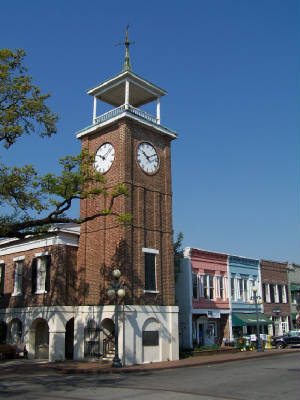
|
| Landmark 1845 clock tower |
The Marina is located right in the heart of historic Georgetown, the third oldest city in South Carolina
(Charleston is #1 and Beaufort #2). After we got docked and organized, we walked into town. Our first stop was
the Tourist Welcome Center, where we got a walking tour map and some other materials to help us plan our day of sight-seeing
tomorrow.
Then we walked to the Kudzu Bakery. Bakery is an understatement for this gourmet extravaganza. The
place has all the baked goods you could hope for in a bakery, but also has freezer cases full of vacuum packed frozen soups
and entrees, half-baked biscuits and breads, organic vegetables, even unusual game food like quail and frog legs.
We walked away with a half key lime pie and the vow to check our galley, and come back with a list tomorrow.
We had a really good dinner at the River Room Restaurant. All the tables have good water views, the
atmosphere is intimate, the food is local and prepared with some creativity, the service is attentive, and the
price reasonable.
We skipped dessert at the River Room, knowing Key Lime Pie awaited us back on the boat. It was tart
and sweet in perfect measure, and the crust was crisp and buttery rich. We aren't sure if we can remember a better tasting
Key Lime Pie.
From beginning to end, it was a perfect day.
Tuesday, April 19, 2005 Georgetown, SC
"Nothing Could Be Finer Than To Be in Carolina in the Morning"
We began the day with breakfast at Thomas's Cafe. Our cruising guide recommended the hotcakes there,
so that's what I ordered. My two blueberry hotcakes practically hung over the edge of my platter-sized plate.
Dick ordered a monstrous breakfast of eggs, toast, hashbrowns, bacon and three silver dollar hotcakes. Thomas's silver
dollars were about eight inches in diameter. Perhaps best of all, Thomas's staff does the bottomless coffee cup routine
flawlessly. If we were picky, we'd mention that the syrup wasn't real maple syrup, but, let's just say we cleaned our
plates, and leave it at that. Needless to say, by the time we waddled out, we were fueled up to face a very busy
day.
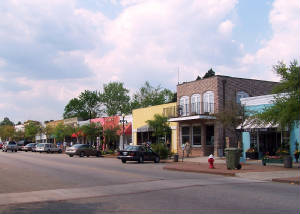
|
| Front Street |
So as not to risk impulse purchases due to shopping while hungry, we walked up to Kudzu Bakery immediately
after breakfast. We stocked up on some entrees and cheese biscuits for our freezer, and pastries to eat while under
way tomorrow, so we can get an early start.
We hauled our puchases back to the boat, then walked the short two blocks to the Rice Museum, where, by
luck and chance we arrived just in time for the first tour of the day.
Georgetown has a museum dedicated to rice, because the town's fortunes were dependent on rice from the early
1700s to the early 1900s. Rice grows in fresh water, and Georgetown is an ideal location for rice plantations, because
it lies at the confluence of three fresh water tidal rivers.
Rice fields were cleared from cypress swamps, then dikes were built with floodgates that would allow river
water in to flood the fields. Because the fields were constantly flooded, the fertility of the soil was continually renewed,
unlike cotton fields, which were often exhausted by single crop farming.
The job of controlling the floodgates was a vital one--the gate would be opened to flood the fields as the
river rose with tidal flow, but had to be closed before the salt water reached that far upstream. If salt water got
in the fileds, they could not be used for several years. One way of determining the salinity of the water was to have
someone wash their hands with a bar of soap at the river's edge. When the soap no longer lathered, the water was getting
salty, and the gates had to be closed.
The rice grown here was known as "Carolina Gold, " not only for its economic impact, but also for its color.
It was polished, not bleached, at first by hand, and later by mills.
During the boom years of rice cultivation in the mid-1800s over 90% of the people in Georgetown were Black
slaves. As was proven after the Civil War, without their free skilled labor rice cultivation in this region was
not economically viable. After the war, the Gulf States began planting rice, and were able to use machinery in its cultivation.
The soil here was too soft and swampy for mechanized cultivation. The final blows to the struggling rice business here
were several severe hurricanes that struck between 1894 and 1906, damaging rice crops and rice fields.
Now the economy of Georgetown is anchored by a steel mill and a paper plant. The wealth may not be
as impressive as it was in the mid-1800s, but it is more evenly distributed among the area's residents, and a stroll
about the neighborhoods gives the impression of a small town that is doing quite well, indeed. (Although we wouldn't
want to live near the iron mill, where all the homes within a on block radius are stained rusty brown or painted a russet
color to camoflage the patina.)
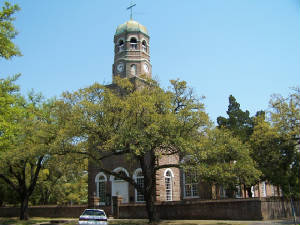
|
| Prince George, Winyah, Episcopal Church |
After the Rice Museum, we grabbed our town map and walking tour map, and headed in the direction of the
UPS Store to mail a package, while looking at the historic homes and churches along the way. The Episcopal Church
was the first principal building in town, built in 1747 using ballast bricks from British ships, with the steeple added in
1824. The sanctuary is very simple, with the original wavy panes still visible in some of the clear glass windows.
Interior walls are painted bright white. The pews are within boxes with doors -- parishoners of early days rented their
space. Now, church goers can sit anywhere, but still tend to be a bit territorial about their usual seat. The boxes are
natural wood, with names, dates, even ships carved into them. Is this how Episcopalians occupy themselves when the sermon
is boring?
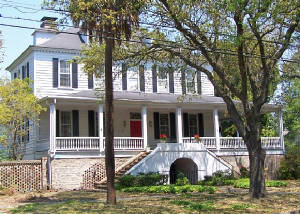
|
| Mary Man House, c. 1775 |
All that walking and no lunch. We deserved an ice cream cone. We had three purveyors to choose
from along Front Street. We chose the one with a sign in the front window declaring 28 flavors of ice cream, 28 flavors
of frozen yogurt and a marble slab for mix-ins. We weren't disappointed.
When we got back to the boat, Dick had time for varnishing, and I had time for web site catch-up work.
Then we had dinner aboard and planned for our departure early tomorrow.
Wednesday, April 20, 2005
Georgetown to Barefoot Landing (North Myrtle Beach)
52.2 miles
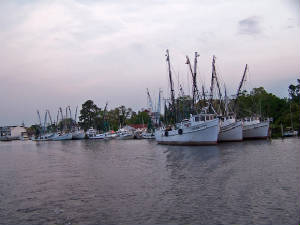
|
| One last look at the marina, beyond the working boats |
Our goal was to leave Georgetown at 7 am, and we were on our way at 6:50, which we think sets a new record
for earliness of Starsong departures, at least under our leadership.
Skipper Bob's guide said that leaving at high tide from Georgetown we could carry a fair tide all the
way to Barefoot Landing. Here's how it works. The ICW is made up of rivers and canals that roughly parallel the
ocean and connect to it by inlets and sounds spaced every five to forty miles or so. Although the ocean tides at the
beach are fairly uniform in their timing, the tides vary greatly along the ICW, due to the size and shape of the inlets and
the course of the rivers and canals. It can take the tidal flow a long time to get from the ocean up a winding river
to the spot where you may be cruising. So, beginning in Georgetown at high tide, 7 am on this day, we were pushed
along by the current of the high tide progressing up the river from an inlet south of us, then as the tide was receding to
an inlet north of us later in the day, it sucked us along with it.
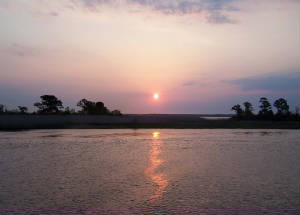
|
| Sunrise under way |
The tidal flow worked just like Skipper Bob said it would, and we got a 1-2 mph boost all the
way. Tidal flow impact can be as strong as 4 mph, and it can work against you, as well as with you. How to
work the tides is just one more thing boaters talk about on the docks and web chat sites. On a boat like ours that cruises
at 8 mph, a 4 mph unfavorable tidal current can wreck your progress worse than a traffic jam on a highway, where at least
you have options to exit onto a side road.
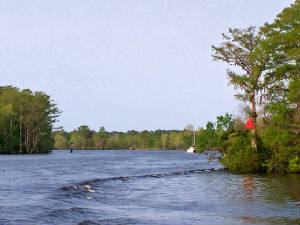
The area we cruised through today was probably our favorite of all the waterways we have been on so
far. Gone were the wide tidal marshes, replaced by heavily wooded shores with cypress trees wading out into the water
knee-deep, and tall pines behind them. Deciduous trees sporting fresh spring green leaves and beards of Spanish moss
crowded the banks between the cypress and the pine. Lily pads floated serenely in calm pools off the river cut. There
were ospreys minding their nests around every turn, and kingfishers hunting in our wake. The birds were in
spring ecstasy -- we could hear their operettas above the drone of our engines.
The day was warm, the skies clear, and the landscape beautiful. We reveled in the joy of cruising.
Then we approached the development of Myrtle Beach. We couldn't help but wonder how long our forested stretch
would last before it was clear cut for a golf course, or worse, unimaginative condos.
Just before we got to Barefoot Landing, we did see an unusual golf course. The course stretches across
the ICW. To get from the holes on one side to the holes on the other, golfers ride a tram suspended from a wire high
above the waterway. Their golf bags rest in racks outside the car. When they get to the other side, they hop out
of the car, put their clubs in a new golf cart, and continue their play.

|
| The golf course sky tram |
Barefoot Landing is a popular stop for boaters. It has a dock with no water, no electricity,
and no facilities. Yet, so many boaters stop here that every night boats are rafted together, parked two to four
deep at the dock.
What's the attraction? First, the dock is free. Second, Barefoot Landing is a complex of about
70 outlet stores and chain boutiques, 15 restaurants and attractions like "Alligator Adventure" and a musical theatre. (There
are also a couple huge tour boats that are constantly popping in and out for sight-seeing cruises, but I'm
sure few boaters take advantage of them.) There are probably plenty of boaters who would make out better
financially just paying to stay at a marina.
We got to Barefoot Landing at a little after noon, and all the spots at the dock were filled. We idled
past, looking for the best fit boat to raft with. We called to another trawler flying a Looper burgee, and they set
down their books, reluctantly we thought, and started to prepare their boat to accept us aside. Then the friendly
Captain of a Canadian trawler called us on the radio, and invited us to raft with him. He was all prepared with fenders
out. We accepted his offer, and he helped us get secured in quick order.
We soon learned that our raft mates, Mike and Sue Johnston, are very experienced at cruising (6 years living
aboard) and rafting (a way of life in Canadian boating). In six years of boating, they claim to have never stayed overnight
at a marina. Dick learned a lot talking with Mike. After Sue got back from shopping later in the day, she gave me some
great brochures for Canadian cruising spots. We look forward to running into them again as we make our way through the
Rideau Canal, their summer stomping grounds.
We headed to the nearest restaurant for lunch, then wandered around a short time to stretch our legs and
get the lay of the shopping land. Then we were back to the boat, no purchases in hand. Dick varnished, Gayl worked
on the website. This is the first place we have been in a while where the temptation to explore ashore was weaker than
the call of the boat to get some work done aboard.
Thursday, April 21, 2002 Barefoot Landing
We got up a little before 7 so we could be showered, dressed and ready to motor up at 8 when Mike
and Sue were leaving. We untied from them, they left, and we tucked back into their place on the dock. Then we
ate breakfast.
Dick did varnish prep work and I took the computer up to the flybridge to work on the website and read a
bit for the rest of the morning. When we got hungry, we decided to wander over to the shopping extravaganza for lunch.
We had an undistinguisnhed bowl of She Crab Soup at a chain restaurant with terrible service.
Certain there must be something good about this stop besides free dockage, we took a walk around the whole
place, checking out all the shops. It was a pretty quick tour, since not too many lured us in. We did make a couple
purchases, though--at a total cost about equal to a night's stay at a nice marina.
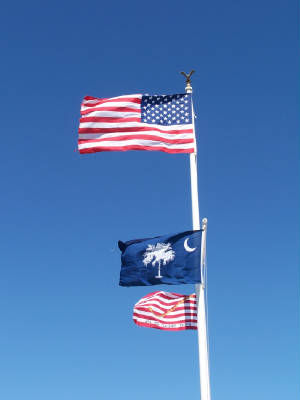
|
| State Flag and First Navy Jack |
Since there isn't much more to say about this stop, and since we will be in North Carolina tomorrow,
now is the time to share some of the interesting general information about South Carolina we have picked up along the
way.
The most obvious first topic is the state flag. Neither one of us can call to mind an image of the state
flag of Ohio, but the South Carolina state flag has been burned in our brains since our first visit here. Why?
Because it has a simple design, and you see it flying everywhere there's an American flag. The flag dates back to 1775.
Its blue background matches the color of South Carolina's Revolutionary War troop uniforms, and the crescent shape is not
the moon, but a silver emblem that appeared on uniform caps. The tree is a palmetto, known elsewhere as a
sabal palm or cabbage palm. The palmetto also adorns the state license plate, and it seems that no town is without some
sort of commercial development named for the palmetto.
We wondered about the other flag beneath the Stars and Stripes. Although it is hard to see the details from
the picture, the flag has 13 stripes, a rattlesnake, and the words "Don't tread on me." The flag is the first Navy
Jack, dating back to 1775. The reason it is flying is that the US Secretary of the Navy has ordered that all
our Navy ships fly it for the duration of the War on Terrorism.
As birders, we like to keep track of state birds. South Carolina's bird is the Carolina Wren, which
we have frequently seen hopping about in the South Carolina underbrush.
On a boat called Starsong, we also like to keep track of state songs. "Nothing Could Be Finer
Than To Be in Carolina" would be a nice choice for a state song. Unfortunately, the official state song, adopted in
1911 by the State Legislature, at the behest of the Daughters of the American Revolution, has an entirely different tone about
it:
Hold up the glories of the dead,
Say how thy elder children bled,
And point to Eutaw's battle bed.
Carolina! Carolina!
There are a lot more verses, but you get the idea. The lyrics are by Henry Timrod, laureate of the
Confederacy.
Just when we were starting to think that this state takes itself too seriously, musically speaking,
we learned that in 2001 the General Assembly declared the official state popular music is "beach music." "What is 'beach music?'" you may ask. It is music associated with the shag, the official state dance, as
declared by General Assembly Act 329 in 1984.
One final state fact. The South Carolina license plate bears the words "Smiling faces. Beautiful places."
Actually, we think that is a pretty good summary of our South Carolina experience.
|
 |
|
|
 |
|
|
 |
|
|
|
|
|
|
 |

